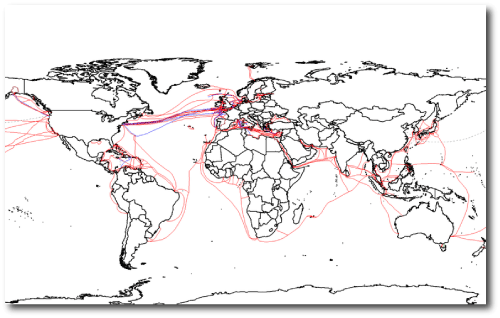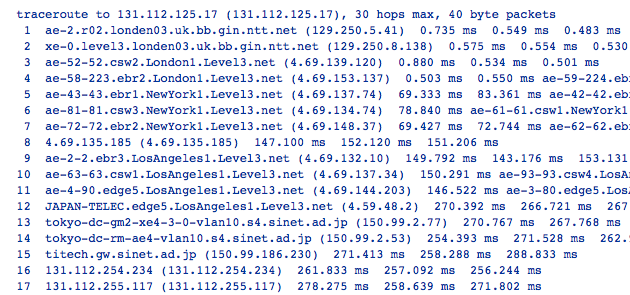The ring of geosynchronous satellites and the global web of submarine cables constitute two of planet Earth’s most remarkable physical features. The moment I press Publish, the diagram just below will be sent — encoded in modulated light — on a profusion of undersea journeys from the Bluehost servers in Utah to Japan, Europe, Australia, South America and beyond. Optical wavelengths are small, the speed of light is fast, and the quantity of data that can be transmitted on optical fiber is impressive. A fairly recent lab-based data transport record involved multiplexing 155 channels, each carrying 100 Gbit/s over a 7000 km fiber.
For the impatient, however, the latencies of the long-haul international fiber connections are something of an issue. The index of refraction in glass is n~1.5, and the cable routes don’t adhere to the great circles. Using NTT’s Looking Glass service, one can run traceroute between far-flung nodes on the Internet. For example, right now, round-trip travel times between London and Tokyo are taking about 265 milliseconds, with routing that runs on the Atlantic and Pacific Ocean bottoms and (effectively) along Route 66:
A quarter of a second round-trip is pretty slow. Light traveling in vacuum along the 9602 km great circle connecting London and Tokyo would do the round-trip in 64 milliseconds, a factor-of-four improvement. Things should get better in 2013, however, when the Arctic Link cable connects Japan to Britain via the Northwest Passage. This line will run at 170 milliseconds round trip.
Even with global warming lending a helping hand, it’s a hassle to lay cables over the top of the planet. A more effective plan is to go straight through. The straight-line distance through the Earth from London to Tokyo is 8719km, implying a minimum round-trip of only 58 milliseconds.
It was thus rather interesting to read of the first actual demonstration of signaling by neutrinos posted to arXiv earlier this month. A team at Fermilab reports that they have established a neutrino communication link with a data rate of 0.1 bits/sec and a bit error rate of 1% over a distance of 1.035 km, along a path that includes 240 m of solid Illinois dolomite.
A one or a zero every ten seconds is very similar to the bit rate that one gets with smoke signals. It’s a staggeringly long way from the petabit-per-second transmission rates that one can currently achieve with a strand of freshly lit fibers. Nonetheless, it’s an exotically high-tech accomplishment, and so it’s fair to overlook the abysmal bandwidth and error rate. What I would like to criticize, however, is the completely lame initial message that was transmitted over the neutrino link: N-E-U-T-R-I-N-O.
Jeez. Did none of the 113 authors of Demonstration of Communication Using Neutrinos appreciate that style is paramount when one is performing expensive high-profile stunts?
In Stancil et al.’s defense, though, the contents of historic first messages have generally been sorely lacking in pizazz. Alexander Graham Bell’s first telephone call consisted of “Watson, come here! I want to see you!” Even worse, was the unreadably uncompressed purple prose transmitted (over the course of 19 hours) on August 16, 1858 as a part of the first transatlantic telegraph messages between Queen Victoria and President Buchanan:
“it is a triumph more glorious, because far more useful to mankind, than was ever won by conqueror on the field of battle. May the Atlantic telegraph, under the blessing of Heaven, prove to be a bond of perpetual peace and friendship between the kindred nations, and an instrument destined by Divine Providence to diffuse religion, civilization, liberty, and law throughout the world.”
Had I been part of the arXiv:1203.2847 author list, I would have agitated to turn the contents of that first message over to the inimitable Oscar Wilde:
“It is a very sad thing that nowadays there is so little useless information.”







You’d think one of these Russian oligarchs would have run cable along the trans-Siberian railway by now…
Perhaps another way of shortening the round trip would be to increase the communication speed… However, the modern scientific viewpoint is that “nothing travels faster than the speed of light”, the reference here is of course to the results from CERN late in 2011 seeming to demonstrate that this cardinal law of physics had been broken.
Here is the full link (to illustrate):
http://www.foxnews.com/scitech/2011/09/22/strange-particles-may-travel-faster-than-light/
“It is the modern that ever becomes old-fashioned.”
Oscar Wilde.
I also note that (from this article):
“Previous studies have found that certain materials can travel faster than light through a medium.”
On the other hand, server farms in Iceland could be good for trans-atlantic traffic:
http://blogs.discovermagazine.com/80beats/2012/04/11/with-plenty-of-cheap-electricity-to-spare-iceland-courts-server-farms/
Great :)